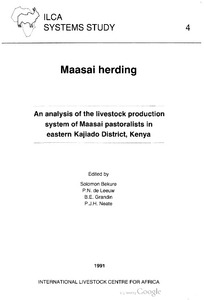A review of mixed farming systems in the semi-arid zone of sub-Saharan Africa
The paper is divided into four chapters. The frist chapter is the introduction. Chapter two discusses the conceptualisation of the farming system with reference to the livestock component and reviews some alternative typologies that have been employed or proposed. A typological framework that is consistent with ILCA's objectives is then outlined.
Animal health services in sub-Saharan Africa: Initial experience with new approaches
Outlines the types of reforms introduced in animal health services over the past decade, summarises past experiences, provides a preliminary assessment of their impact, and indicates what lessons need to be taken into account in future policy adjustments and project investments. The discussion concentrates on World Bank- supported accessibility of the data to the authors.
Dairy marketing in Ethiopia: Markets of first sale and producers' marketing patterns
This study is part of a larger study on dairy marketing in Ethiopia, and concentrates on the producers'end of the marketing chain. Specifically, the markets of first sale used by dairy producers were identified and the marketing patterns of three categories of dairy producers (intra-urban, peri-urban and peasant) were investigated.
ILCA 1990: Annual report and programme highlights
Presents ILCA's achievements in 1990 in a popular, easily read style. The Cattle Milk and Meat Thrust highlight focusses on peri-urban dairying, and particularly the work of collaborative programme with KARI. The highlights of the Small Ruminant Meat and Milk Thrust are linked by their focus on interactions between animals and other components of the agricultural system.
Maasai herding: An analysis of the livestock production system of Maasai pastoralists in eastern Kajiado District, Kenya
The first chapter gives a brief description of a pastoral production system, as envisaged by the study team and outlines the multi-disciplinary approach of the study, its sampling design and the data collected. Chapters 2 & 3 describe Kenya's biophysical and socio-economic environments, within which the Maasai livestock production system operates.
Natural resources and rural agriculture: In balance or imbalance? The example of Botswana's rangelands
Assesses the effect (balance or imbalance) of the present relationships between the natural resource base and human activities; examines the role of some potentially destabilising forces, i.e, international markets, government programmes and socio-economic stratification; and reviews government's role in terms of its contributions to prudent natural resource management and options for the promo
International Livestock Centre for Africa's Rangeland Research Program in the Arid and Semi-Arid Zones: Review and Recommendations
Ley 6.290 - Ley de conservación del suelo agrícola.
La presente Ley introduce el marco normativo que rige las acciones tendientes a la conservación del suelo agrícola, es decir al mantenimiento y mejoramiento de su capacidad productiva.
Equity, equality and appropriate distribution : multiple interpretations and Zimbabwean usages
Budgeting and allocation of feed resources
Presents procedures for feed budgeting and allocation developed to access the quantity and quality of all feed components and to determine the production goals of each enterprise and allocates feed in relation to their requirements within the framework of overall feed supplies.
Economic considerations for smallholder cattle milk and meat production and marketing. I. Economic policies, supporting institutions, marketing and demand
Discusses the considerations relating to economic policy, supporting institutions and marketing and consumer demand. Classifies and discusses market functions and analyses market organization and institutions of marketing. Looks into the purpose of marketing studies. Discusses some lessons from past livestock marketing studies.












